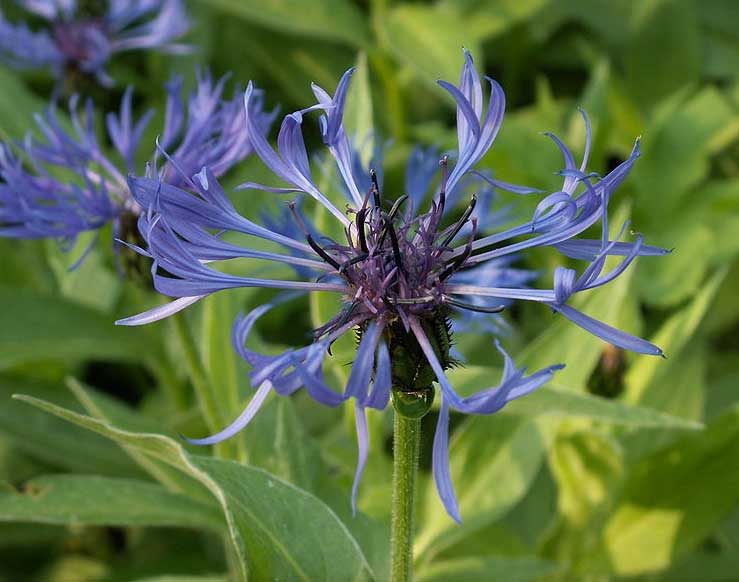
Centaurea montana (*)
Classification System: APG IV
Superregnum: Eukaryota
Regnum: Plantae
Cladus: Angiosperms
Cladus: Eudicots
Cladus: Core eudicots
Cladus: Asterids
Cladus: Campanulids
Ordo: Asterales
Familia: Asteraceae
Subfamilia: Carduoideae
Tribus: Cardueae
Subtribus: Centaureinae
Genus: Centaurea
Species: Centaurea montana
Name
Centaurea montana L., 1753
Synonyms
Centaurea angustifolia Mill.
Centaurea carpathica Geners.
Centaurea caucasica Bieb. ex DC.
Centaurea chlorantha Adams ex Ledeb.
Centaurea floccosa Schloss. ex Vukot.
Centaurea graminifolia Pourr. ex Willk. & Lange
Centaurea leucantha Web. & Mohr
Centaurea montana var. pradensis O. de Bolòs & J. Vigo
Centaurea serrata Kitt.
Centaurea seusana Benth.
Cyanus angustifolius (Mill.) Sojak
Cyanus montanus (L.) Hill
Jacea alata Lam.
Setachna montana (L.) Dulac
Homonyms
Centaurea montana Auct. ex Willk. & Lange = Centaurea triumfettii subsp. triumfettii
Centaurea montana Costa = Centaurea triumfettii subsp. semidecurrens (Jord.) J. Dostal
Distribution
Native distribution areas:
Continental: Europe
England, Ireland, Northern Ireland, Norway, France, Andorra, Spain, Netherlands, Belgium, Luxembourg, Germany, Switzerland, Austria, Liechtenstein, Italy, Poland, Czech Republic, Slovakia, Slovenia, Croatia, Bosnia & Hercegovina, Serbia & Kosovo, Estonia, Latvia, Lithuania, NW-European Russia
References: Brummitt, R.K. 2001. TDWG – World Geographical Scheme for Recording Plant Distributions, 2nd Edition
References
Linnaeus, C. 1753. Species Plantarum. Tomus II: 911. Reference page.
Links
Hassler, M. 2018. Centaurea montana. World Plants: Synonymic Checklists of the Vascular Plants of the World In: Roskovh, Y., Abucay, L., Orrell, T., Nicolson, D., Bailly, N., Kirk, P., Bourgoin, T., DeWalt, R.E., Decock, W., De Wever, A., Nieukerken, E. van, Zarucchi, J. & Penev, L., eds. 2018. Species 2000 & ITIS Catalogue of Life. Published online. Accessed: 2018 May 08. Reference page.
International Plant Names Index. 2018. Centaurea montana. Published online. Accessed: May 08 2018.
The Plant List 2013. Centaurea montana in The Plant List Version 1.1. Published online. Accessed: 2018 May 08.
Tropicos.org 2018. Centaurea montana. Missouri Botanical Garden. Published online. Accessed: 08 May 2018.
USDA, ARS, Germplasm Resources Information Network. Centaurea montana in the Germplasm Resources Information Network (GRIN), U.S. Department of Agriculture Agricultural Research Service. Accessed: 07-Oct-06.
Vernacular names
العربية: قنطريون جبلي
беларуская: Васілёк мяккі
čeština: Chrpa horská
Cymraeg: Y Benlas Luosflwydd
dansk: Bjerg-Knopurt
Deutsch: Berg-Flockenblume
English: Perennial Cornflower
español: Centaura de las montañas
suomi: Vuorikaunokki
français: Centaurée des montagnes
italiano: Fiordaliso montano
norsk bokmål: Honningknoppurt
Nederlands: Bergcentaurie
polski: Chaber górski
русский: Василёк горный
slovenčina: Nevädza horská
svenska: Bergklint
Centaurea montana, the perennial cornflower,[1] mountain cornflower, bachelor's button, montane knapweed or mountain bluet, is a species of flowering plant in the family Asteraceae, endemic to Europe. It is widespread and common in the more southerly mountain ranges of Europe, but is rarer in the north. It escapes from gardens readily, and has thereby become established in the British Isles, Scandinavia and North America. This plant has become an invasive species in British Columbia, Canada.[2] Centaurea montana grows in meadows and open woodland in the upper montane and sub-alpine zones, in basic areas. It grows to 30–70 centimetres (12–28 in) tall, and flowers mainly from May to August.
Centaurea montana may be distinguished from other Centaurea species in the region by its usually entire leaves, and the blue-purple colour of the outermost ray florets. It may be distinguished from the cornflower, Centaurea cyanus, by having a single (rarely up to three) flower heads, and by its being perennial, whereas the cornflower has many flower heads and is annual. The closely related C. triumfettii has more narrowly winged stems, narrower leaves and grows in rockier areas.
Taxonomy
The Latin specific epithet montana refers to mountains or coming from mountains.[3]
Ornamental use
Centaura de las montañas - Centaurea montana (9583677454).jpg
Centaurea montana grows in gardens where it grows best in sunny positions. It tolerates some light shade. Since the plant is evergreen it can use the light in winter and early spring when deciduous trees and shrubs have no leaves. It tolerates deciduous shade better than evergreen shade and prepares to flower while deciduous plant are bare. Therefore, it can flower reasonably well in light deciduous shade. If the plant is dug up, a new plant can eventually regenerate from small pieces of root left in the soil. Centaurea montana grows well in soils varying from light sand to heavy clay. The plant also grows well in acid, neutral or very alkaline soils. It tolerates drought but cannot tolerate waterlogged conditions.[4]
This plant is inedible; however, it is a popular medicinal plant in Central Europe.
References
BSBI List 2007 (xls). Botanical Society of Britain and Ireland. Archived from the original (xls) on 2015-06-26. Retrieved 2014-10-17.
"INVASIVE PLANT Mountain Bluet Centaurea montana". Invasive Species Council of BC. Retrieved 6 June 2021.
Archibald William Smith A Gardener's Handbook of Plant Names: Their Meanings and Origins, p. 239, at Google Books
"Centaurea montana L." Plants for a Future. Retrieved 2013-06-02.
Retrieved from "http://en.wikipedia.org/"
All text is available under the terms of the GNU Free Documentation License

